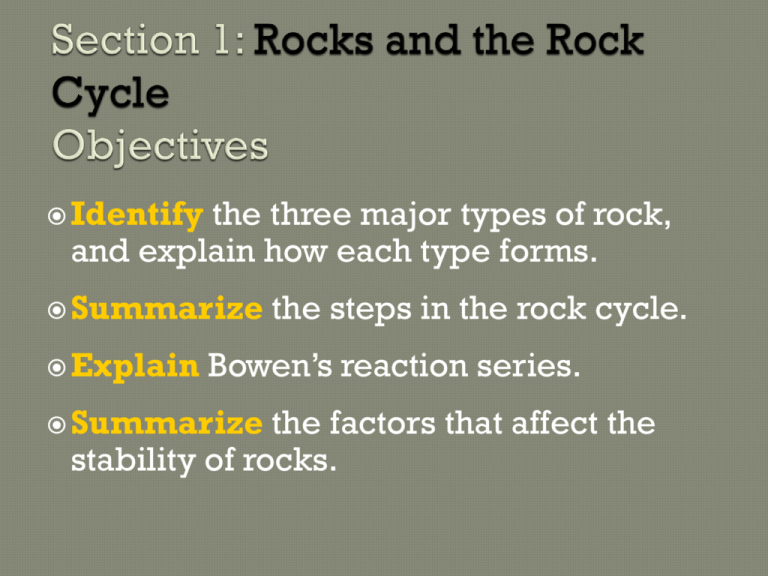Rock Cycle
advertisement

Identify the three major types of rock, and explain how each type forms. Summarize Explain the steps in the rock cycle. Bowen’s reaction series. Summarize the factors that affect the stability of rocks. List as much as you know about rocks • How do they form? • Are their different types? • How can we tell them apart? The material that makes up the solid parts of Earth is known as rock. Based on the processes that form and change the rocks of Earth’s crust, geologists classify rocks into three major types by the way the rocks form. 1. Igneous rock forms when magma, or molten rock, cools and hardens. 2. Sedimentary rock forms when sediment deposits that form when rocks, mineral crystals, and organic matter have been broken into fragments, called sediments, are compressed and cemented together. 3. Metamorphic rock forms when existing rock is altered by changes in temperature and/or pressure or chemical processes. Any of the three major types of rock can be changed into another of the three types. Geologic forces and processes cause rock to change from one type to another. Rock Cycle the series of processes in which rock forms, changes from one form to another, is destroyed, and forms again by geological processes The diagram below shows the rock cycle. All rock has physical and chemical properties that are determined by how and where the rock formed. The rate at which rock weathers and the way that rock breaks apart are determined by the chemical stability of the minerals in the rock. Bowen’s reaction series the simplified pattern that illustrates the order in which minerals crystallize from cooling magma according to their chemical composition and melting point The pattern of mineral formation from magma depends on the chemical composition of the magma. Summarize Bowen’s reaction series. As magma cools and solidifies, minerals crystallize out of the magma in a specific order that depends on their melting points. The rate at which mineral chemically breaks down is dependent on the chemical stability of the mineral. Chemical stability is a measure of the tendency of a chemical compound to maintain its original chemical composition rather than break down to form a different chemical. The chemical stability of minerals is dependent on the strength of the chemical bonds between atoms in the mineral. Rocks have natural zones of weakness that are determined by how and where the rocks form. When rock that formed under intense pressure is uplifted to Earth’s surface, decreased pressure allows the joints or fractures to open. Once these weaknesses are exposed to air and water, the processes of chemical and mechanical weathering begin. Name the three types of rocks How do they form?





